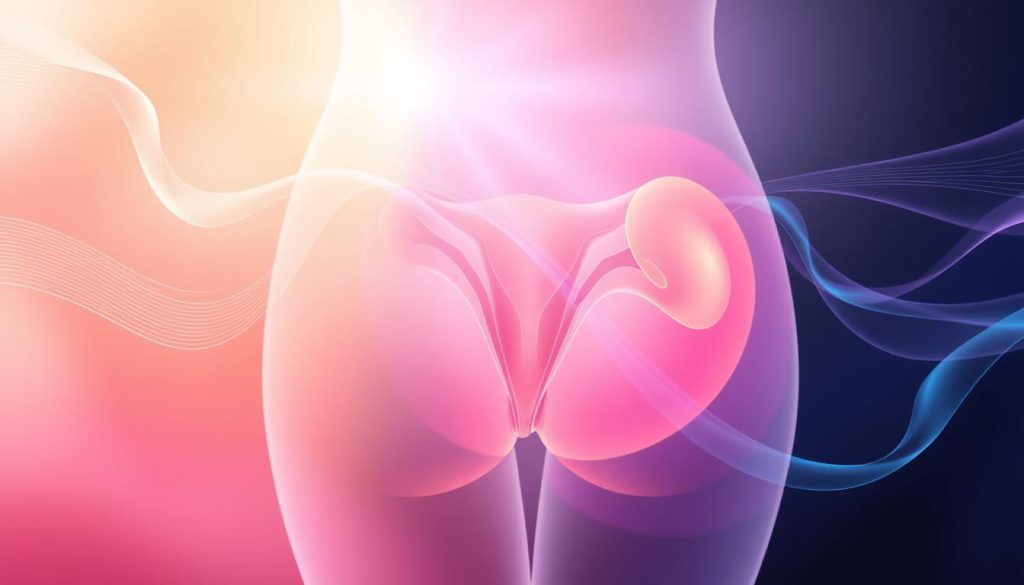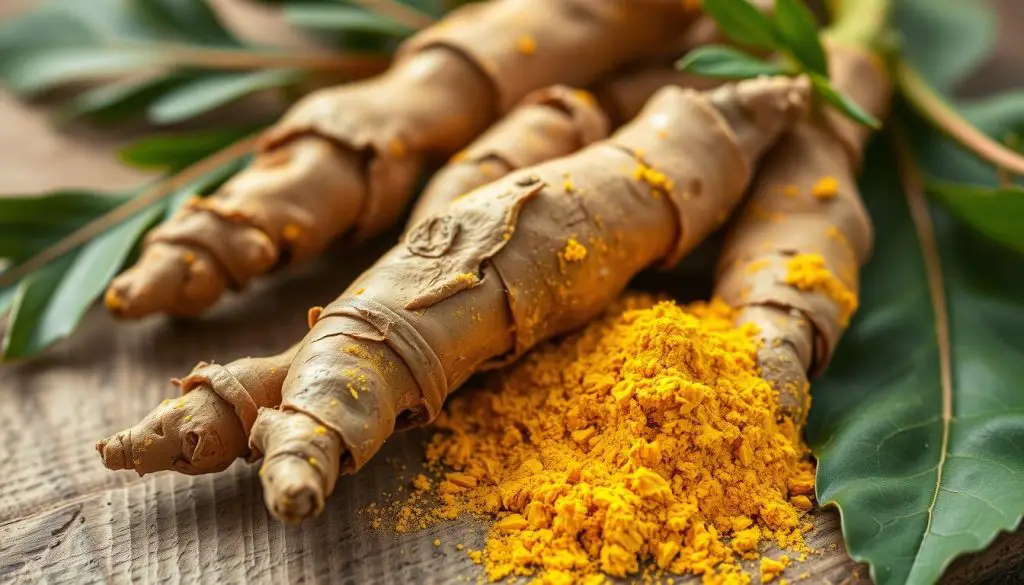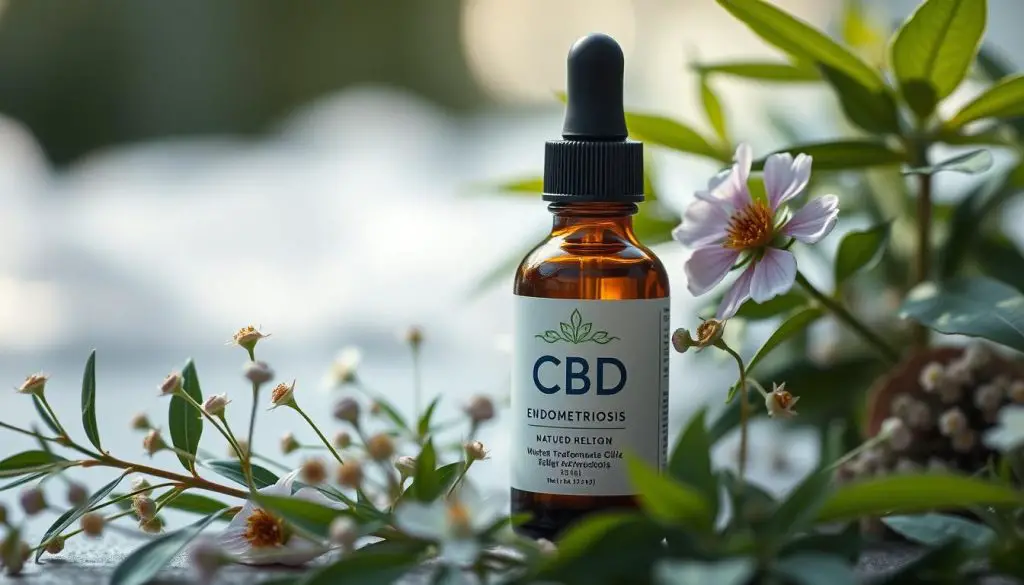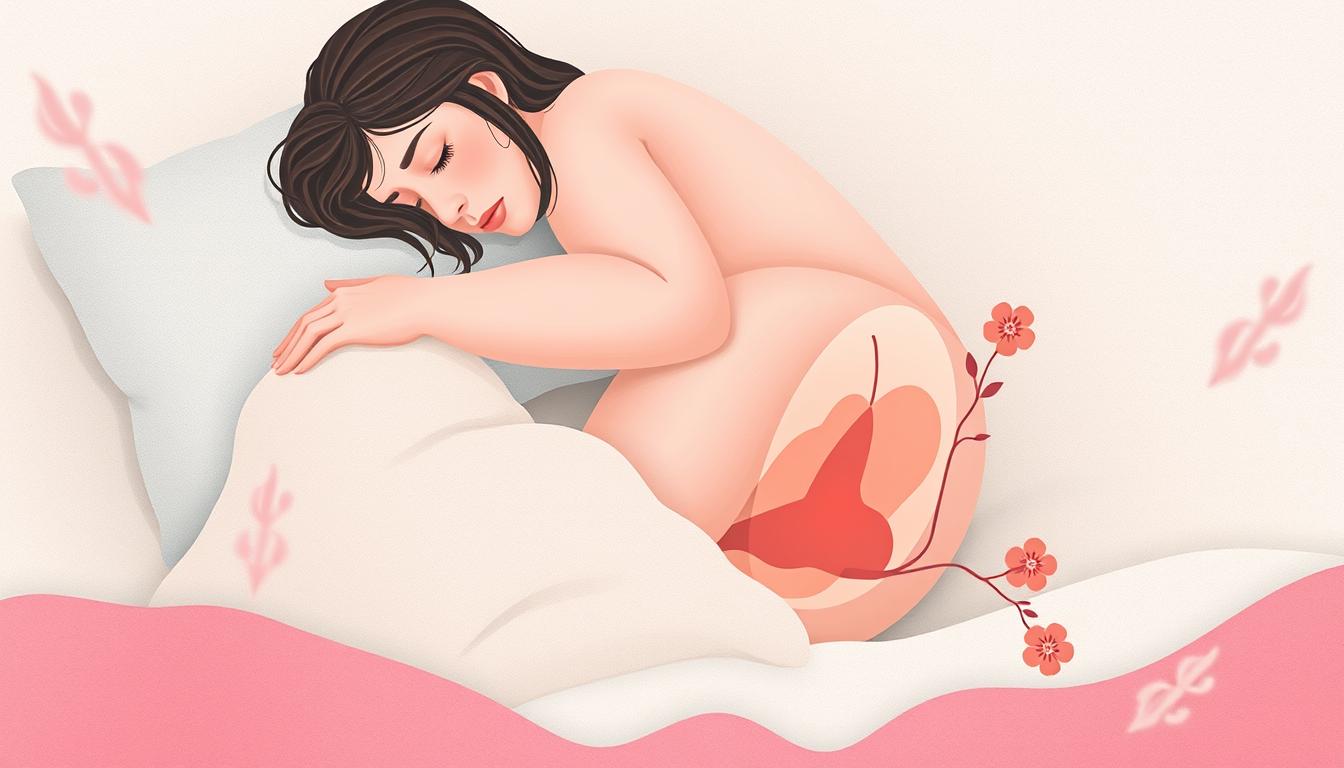Do your menstrual cramps make it hard to move during your period? You’re not alone. Millions of women worldwide face the tough effects of endometriosis. This condition can cause severe period pain. But, there are ways to manage this pain and improve your life.
Endometriosis is when tissue like the uterine lining grows outside the uterus. This tissue thickens, breaks down, and bleeds with each cycle. But, it can’t leave the body, causing inflammation and pain. Symptoms include painful periods, chronic pain, and even infertility.
If endometriosis pain is disrupting your life, there’s hope. You can try natural remedies, dietary changes, and medical treatments. This guide will help you find relief and take back control of your life.
Understanding Endometriosis and Its Painful Symptoms
Endometriosis is a chronic condition where tissue grows outside the uterus. This tissue acts like the uterine lining, thickening and bleeding with each cycle. Symptoms include painful periods, chronic pelvic pain, and heavy menstrual. Some women also face infertility.
What is Endometriosis?
Endometriosis affects about 10% of women of reproductive age, or 176 million worldwide. It’s a condition where tissue grows outside the uterus, causing pain and discomfort. This misplaced tissue responds to hormonal changes, leading to inflammation and scarring.
Common Symptoms of Endometriosis
- Painful periods (dysmenorrhea) – Affecting around 90% of women with endometriosis compared to 67% of women without the condition.
- Chronic pelvic pain – Up to 50% of women with endometriosis experience non-period pelvic pain.
- Painful intercourse (dyspareunia) – Approximately 30-50% of women with endometriosis report experiencing pain during sex.
- Heavy menstrual bleeding – Around 20-30% of women with endometriosis suffer from long or heavy periods.
- Infertility – It is estimated that 10-15% of women with endometriosis have trouble getting pregnant.
Other symptoms include chronic lower back pain, belly pain, and fatigue. Some women may also experience migraines, allergies, and irregular periods. The pain’s severity doesn’t always match the disease’s extent.
| Symptom | Prevalence Among Women with Endometriosis |
|---|---|
| Painful periods | 90% |
| Chronic pelvic pain | 50% |
| Painful intercourse | 30-50% |
| Heavy menstrual bleeding | 20-30% |
| Infertility | 10-15% |
If you’re experiencing these endometriosis symptoms, see a doctor. Early treatment can help manage pain and improve your life.
Natural Remedies for Easing Endometriosis Pain
If you’re dealing with endometriosis pain, natural remedies might help. These methods can ease inflammation, relax muscles, and boost your mood. You can try heat therapy, pelvic massage, dietary changes, and herbal supplements. These natural remedies for endometriosis offer relief.
Heat therapy is a good start. Using a heating pad or a warm bath can ease muscle cramps and pelvic pain. Pelvic massage also helps by improving blood flow and reducing pain. Research shows massage or osteopathic treatment can help with endometriosis symptoms.
Changing your diet can also help. Eating foods that fight inflammation, like healthy fats, can reduce pain. Keeping a food diary helps you spot and avoid foods that make symptoms worse.
Herbal supplements like turmeric, resveratrol, and green tea extract are promising. They have anti-inflammatory and antioxidant properties that may slow endometrial tissue growth and ease symptoms.
Light exercise, like yoga or pelvic floor exercises, is also beneficial. It boosts endorphins and improves health, which can help reduce pelvic pain.
While natural remedies are helpful, always talk to your healthcare provider. They can help you create a treatment plan that suits your needs and offers the best relief.
Heat Therapy: A Simple Way to Relax Cramping Muscles
Dealing with endometriosis cramps can be tough. But, heat therapy is a simple and effective way to ease the pain. Using a heating pad or a warm bath can relax your muscles and give you quick relief. The warmth boosts blood flow, reduces inflammation, and eases your discomfort.
For a quick fix, try a microwavable heat pad or a rechargeable cordless heat wrap. You can also make your own heating pad with rice, dried beans, or Epsom salt. Just make sure the temperature is below 140°F and use it for 15-20 minutes at a time. Adding essential oils like lavender or marjoram can make it even more relaxing.
For a more immersive experience, a warm bath can be incredibly soothing. The water’s warmth relaxes your muscles and calms your mind. You can also make your own bath salts with Epsom salt and essential oils for extra pain relief.
Always listen to your body when using heat therapy. Stop if you feel any discomfort or skin irritation. If your cramps are severe or you have other symptoms, talk to your healthcare provider. With some trial and error, you’ll find the best heat therapy for your endometriosis pain.
Pelvic Massage: Increasing Blood Flow for Pain Relief
If you’re dealing with endometriosis pain, try pelvic massage. It’s a gentle way to boost blood flow to sore spots. This can ease muscle tension and cut down on swelling. Increasing blood flow also helps break up scar tissue and adhesions. This can lessen the pain and discomfort of endometriosis.
Benefits of Pelvic Massage for Endometriosis
Pelvic massage can help in many ways for those with endometriosis:
- Improved blood circulation to the pelvic area, which can help reduce inflammation and relax tense muscles
- Reduced muscle tension in the abdomen, lower back, and pelvic area, easing cramping and discomfort
- Breakdown of scar tissue and adhesions, which can contribute to pain and discomfort
- Enhanced stress relief and relaxation, which can help manage the emotional toll of endometriosis
- Increased endorphin release, the body’s natural pain-relieving chemicals, to help alleviate discomfort
Adding pelvic massage for endometriosis to your routine might cut down on period pain. It could also make your life better overall.

Always talk to a healthcare provider or massage therapist skilled in manual therapy for endometriosis. They can guide you to the best approach for your needs. With the right benefits of pelvic massage, you can naturally increase blood flow for endometriosis pain relief and manage this chronic condition.
Over-the-Counter Pain Relievers: Reducing Inflammation
If you’re dealing with endometriosis pain, over-the-counter NSAIDs like ibuprofen and naproxen can help. These over-the-counter pain relievers for endometriosis reduce inflammation. This can ease the cramping and discomfort you feel.
Studies show NSAIDs beat placebos in easing severe period pain. Girls and women not taking NSAIDs had severe pain in 82 out of 100 cases. But, only 51 out of 100 who took NSAIDs felt the same pain. NSAIDs for endometriosis pain like ibuprofen for menstrual cramps and naproxen for period pain work better than acetaminophen at reducing inflammation and easing discomfort.
To get the most from these over-the-counter pain relievers for endometriosis, follow the label instructions. Talk to your healthcare provider about the right dosage and how often to take it. Remember, NSAIDs are for occasional and short-term use. Long-term use can lead to side effects.
Exploring natural remedies and lifestyle changes can also help with endometriosis symptoms. Heat therapy, pelvic massage, dietary changes, and stress-reducing techniques can improve your life. There are many ways to manage this condition and enhance your quality of life.
Dietary Changes: Identifying and Avoiding Trigger Foods
If you’re dealing with endometriosis pain, changing your diet might help. Some foods can make symptoms worse, while others can help. By finding and avoiding your trigger foods, you can better manage your condition.
Gluten-Free Diet and Endometriosis Symptoms
Some women find relief from endometriosis by going gluten-free. Gluten, found in wheat, rye, and barley, can cause inflammation. Cutting out gluten might ease your pain and symptoms. Try a gluten-free diet to see if it helps you.
Keeping a Food Diary for Better Management
Keeping a food diary is also helpful. It lets you track what you eat and how you feel. This way, you can find out which foods trigger your symptoms. Then, you can make better choices to reduce pain and complications.
- Dairy products
- Red meat
- Processed carbohydrates
- Caffeine
- Alcohol
Being mindful of your diet can help you manage your endometriosis. It might reduce your need for medication. Remember, everyone is different. It might take some time to find the right gluten-free diet for endometriosis for you.

Rest and Relaxation: Reducing Stress and Fatigue
Endometriosis can be very tiring, both physically and emotionally. It’s important to take breaks and do things that help you relax. Activities like deep breathing or meditation can help. Getting enough sleep is also key to reducing pain and fatigue.
Yoga is a great exercise for those with endometriosis. Studies show it can help with symptoms like bloating and cramping. It can also improve sleep and mental health.
Using techniques like pelvic massage or a heating pad can help too. Heating pads can improve blood flow and relax muscles. Yoga and gentle exercises can also help with cramping.
Rest is very important for managing endometriosis symptoms. By taking care of yourself and using relaxation techniques, you can better manage this condition. This can improve your life quality.
Herbal Supplements: Exploring Natural Pain Relief Options
Some women find relief from endometriosis pain with herbal supplements. These natural remedies can help with pain and inflammation. They can be a good part of a pain management plan.
Turmeric: A Possible Anti-Inflammatory Aid
Turmeric is known for its anti-inflammatory properties. It contains curcumin, which may help with endometriosis pain and inflammation. Some women say turmeric helps with menstrual cramps and other symptoms.
Other herbs like white peony, licorice, and Sea buckthorn with St. John’s wort may also help. They could reduce inflammation and discomfort. But, more research is needed to confirm their effectiveness.
Remember, the quality and effectiveness of herbal supplements can vary. Always talk to a healthcare professional before trying new supplements. Exploring these options can help you find a natural way to manage your symptoms.

Omega-3 Fatty Acids: Preventing Endometrial Tissue Growth
If you’re dealing with the painful symptoms of endometriosis, you may want to consider adding more omega-3 fatty acids to your diet. Emerging research suggests that these essential nutrients could help prevent the abnormal growth of endometrial tissue associated with this condition.
Omega-3s are known for their potent anti-inflammatory properties, which may be beneficial in managing endometriosis. By inhibiting the development of new endometrial lesions, omega-3s could potentially help limit the progression of the disease and alleviate related symptoms.
Good dietary sources of omega-3 fatty acids include fatty fish like salmon, mackerel, and sardines. You can also obtain these nutrients through high-quality fish oil supplements. Incorporating more omega-3s into your routine may be a natural way to support your body’s efforts to manage endometriosis.
While more research is needed, the available evidence suggests that omega-3 fatty acids may play a valuable role in preventing endometrial tissue growth and reducing the inflammatory symptoms of endometriosis. Talk to your healthcare provider to explore how adding omega-3s to your treatment plan could potentially benefit you.
CBD Oil: A Possible Pain Relief Option
If you’re struggling with endometriosis pain, CBD oil might be worth a. It’s a compound from the hemp plant known for its anti-inflammatory and pain-relieving effects.
Menstrual cramps can be really tough for many women. Endometriosis pain is even worse. Some people look for natural ways to feel better, and CBD oil is one option.
Research shows CBD oil could help with endometriosis pain. It works with the body’s endocannabinoid system, which helps with pain, inflammation, and mood. This might help reduce the pain and discomfort from endometriosis.
CBD oil comes in many forms, like tinctures, creams, capsules, and gummies. It’s important to pick a high-quality, tested product that meets legal THC limits. Brands like Vijayadi Vati by Vedi Herbals and CannaPain Cannabis Oil by Vedi Herbals are made for menstrual pain.
Start with a small dose of CBD and slowly increase it as needed. Using CBD regularly can help over time. Adding it to other self-care activities, like heat therapy and exercise, might help even more.
Even though there’s not a lot of research on CBD and endometriosis, its natural benefits are promising. Always talk to your doctor before adding CBD to your treatment plan.

Light Exercise: Boosting Endorphins and Overall Health
Endometriosis can cause a lot of pain and discomfort in the pelvic area. Adding light exercise to your daily routine might help ease some of this pain. Exercise releases endorphins, which are natural painkillers that can help reduce the pain from endometriosis.
Exercise also helps improve your overall health and reduce inflammation. These are key in managing endometriosis symptoms. Even simple activities like stretching or low-impact workouts can help increase mobility and improve well-being for those with this chronic condition.
Pelvic Floor Exercises for Endometriosis Pain
Pelvic floor exercises are a great option for endometriosis. These exercises target the muscles in the pelvic area. They can help reduce pelvic pain and discomfort often seen in endometriosis. Adding pelvic floor exercises to your routine can improve your physical health with endometriosis.
It’s important to start slowly and listen to your body when trying new exercises. Talk to your healthcare provider to create a plan that fits your needs and symptoms.
By embracing light exercise and endorphin release, you can take a big step towards managing endometriosis symptoms. This can improve your overall quality of life.
Medical Treatments: When Home Remedies Aren’t Enough
Natural remedies and lifestyle changes can help with endometriosis symptoms. But sometimes, medical treatments are needed when these methods don’t work. Your doctor might suggest hormone therapy, like birth control or certain hormones, to slow down endometrial growth.
In severe cases, laparoscopy might be needed to remove endometrial lesions or adhesions. Prescription pain meds can also help when other treatments fail.
Hormone therapy can balance your menstrual cycle and lower estrogen levels. This slows down endometriosis growth. Surgery, like removing endometrial or scar tissue, might be suggested if symptoms don’t improve. Pain meds, both over-the-counter and prescription, can ease severe menstrual cramps and pelvic pain.
It’s key to work with your doctor to find the right medical treatment for you. They can discuss the pros and cons of each option. This way, you can manage your endometriosis effectively. Remember, there are medical treatments available to help you cope with pain.
Source Links
- https://www.mayoclinic.org/diseases-conditions/endometriosis/symptoms-causes/syc-20354656
- https://www.endofound.org/painful-periods
- https://www.webmd.com/women/endometriosis/understanding-endometriosis-symptoms
- https://nyulangone.org/news/endometriosis-six-symptoms-you-should-never-ignore
- https://www.topdoctors.co.uk/medical-articles/know-difference-between-regular-period-pain-endometriosis
- https://www.healthline.com/health/home-remedies-for-endometriosis
- https://www.verywellhealth.com/natural-treatments-for-endometriosis-89275
- https://natalist.com/blogs/learn/natural-remedies-for-endometriosis?srsltid=AfmBOopSCzb1V-CJsrpD7Qn0SzjAijk3sjWTNmf6XdQwsFUOzq-KZ7pM
- https://www.webmd.com/women/ss/slideshow-get-rid-of-cramps
- https://www.verywellhealth.com/how-to-make-a-homemade-heating-pad-3520622
- https://www.medicalnewstoday.com/articles/323346
- https://www.westendwellness.ca/blogs/massage-therapy-for-your-period-cramps
- https://pressmodernmassage.com/blogs/going-deep/massage-for-period-cramps
- https://www.ncbi.nlm.nih.gov/books/NBK279323/
- https://myhealth.alberta.ca/Health/aftercareinformation/pages/conditions.aspx?hwid=uf7084
- https://www.healthline.com/health/pain-relief/otc-anti-inflammatories
- https://healthmatters.nyp.org/what-to-eat-during-your-period-foods-that-help-reduce-cramps-and-foods-to-avoid/
- https://www.medicalnewstoday.com/articles/foods-like-meat-sugar-and-coffee-may-worsen-menstrual-cramps-research-shows
- http://www.medparkhospital.com/en-US/lifestyles/diet-and-menstruation
- https://www.healthline.com/health/positions-to-help-period-cramps
- https://www.plannedparenthood.org/learn/health-and-wellness/menstruation/what-can-i-do-about-cramps-and-pms
- https://www.motrin.com/adults/period/period-pain-relief
- https://www.everydayhealth.com/treatment/womens-health/ways-to-relieve-period-cramps/
- https://www.ncbi.nlm.nih.gov/pmc/articles/PMC7387104/
- https://www.medicalnewstoday.com/articles/321402
- https://www.healthline.com/nutrition/endometriosis-diet-tips
- https://vediherbals.com/blogs/blog/cannabis-for-period-cramps-how-cbd-can-help-ease-your-menstrual-pain?srsltid=AfmBOoqAnqJkj_2XpXK2tZTdJKvgOqmRB8Dvv-v6d2rqW3odi2uIFtnQ
- https://www.ncbi.nlm.nih.gov/pmc/articles/PMC9780805/
- https://www.yourdaye.com/vitals/cbd/how-cbd-could-be-a-game-changer-for-period-pain/
- https://www.thewomens.org.au/health-information/periods/healthy-periods/exercise-diet-periods
- https://www.ncbi.nlm.nih.gov/pmc/articles/PMC6753056/
- https://www.healthline.com/health/womens-health/menstrual-cramp-remedies
- https://www.healthpartners.com/blog/13-ways-to-stop-period-pain/
- https://www.healthline.com/health/womens-health/how-to-get-rid-of-cramps
